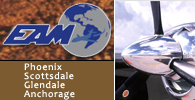If so, there are a couple of reasons why it may be doing that. First, note that the hydraulic cylinder on the nose gear is the steering cylinder and not a shimmy damper. Twin Commanders do not use a hydraulic shimmy damping system. Damping of nose gear shimmy is accomplished by a pair of spring loaded friction pads, sitting in pockets located in the forward and aft steering collar halves, riding in the groove of the nose landing gear strut. There are several things that can affect the performance of the system allowing the nose gear to shimmy.
First, if the nose gear centering cam pin has a bad o-ring, or the centering cam pin port in the strut is badly elongated and hydraulic fluid is seeping out of the port, fluid seepage will naturally flow down into the groove for the anti-shimmy pads and lubricate the pads. Just exactly what one does not want. Any signs of leakage should be quickly addressed by replacement of worn parts. One element of CK-159 installs a steel bushing into the nose gear strut to address a worn/elongated centering cam pin port.
The other possibility is that the steering collar halves need to be tightened to increase the spring force on the pads, but not too much or steering may become very difficult. The AMM (Aircraft Maintenance Manual) calls for several steps to check if there is the correct number of shims to get the proper amount of friction. The process specified in the AMM has 24 individual steps. The process is best explained in the Jetprops AMM Ch 32-20-00 calling for performing the checks in two major steps: First with no strut pressure (this step has a specified time of travel), then followed by a check with the strut pressurized to a specific value (this step simply states that the nose landing gear should center).
If you are experiencing a nose gear shimmy, contact your favorite Twin Commander Service Center and ask them to perform the check procedure spelled out in the Jetprops AMM Ch 32-20-00. Note: The 690/A/B manual does not explain this process even though it is the same.
Eagle Creek Aviation Service’s Mike Grabbe has been servicing Twin Commanders since 1974. He has been a factory service representative, and is currently the Twin Commander Factory Authorized Training Provider. He can be contacted at [email protected].


 Shrike Commander flown by Erick Teeters and Brian Rikeman over Lake Powell, Arizona.
Shrike Commander flown by Erick Teeters and Brian Rikeman over Lake Powell, Arizona. 

